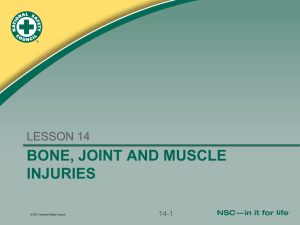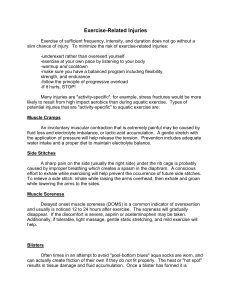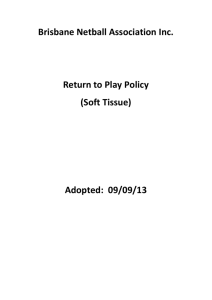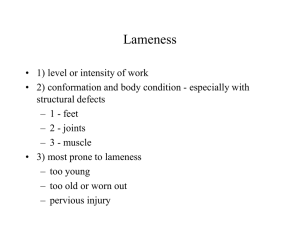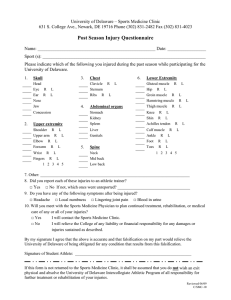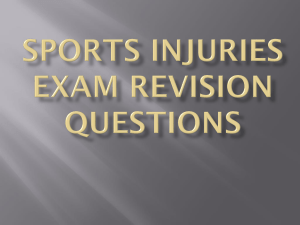Ch 4 Lesson 5 Physical Activity Injuries
advertisement
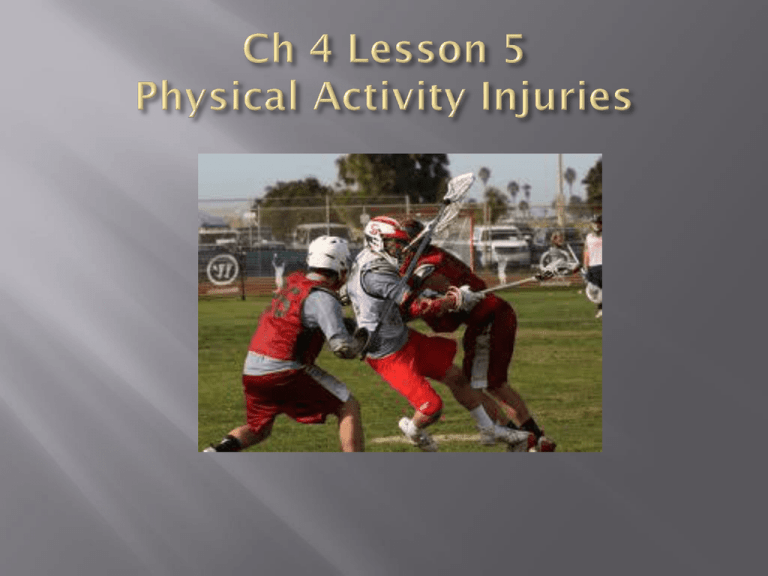
By the end of this lesson you will be able to: Identify weather-related risks associated with various physical activities Analyze strategies for preventing & responding to accidental injuries related to physical activity Identify physical activity injuries requiring professional health services for people of all ages Temperatures can be extremely high or extremely low. Factors like wind, humidity, and air pollution can increase your risk of injury. Also pay attention for weather warning for tornados, thunderstorms, or blizzards. Heat Cramps – muscle spasms that result from a loss of large amounts of salt and water through perspiration. Heatstroke – a condition in which the body loses the ability to rid itself of excess heat through perspiration. This causes Hyperthermia – a sudden increase in body temperature. Overexertion – over working the body. This is related to hot weather problems. Example is heat exhaustion, cold clammy skin, dizziness, headache, shortness of breathe. Frostbite - a condition that results when body tissue becomes frozen. Early signs called frost nip, this is when skin becomes white. Hypothermia – a condition in which the body temperature becomes dangerously low. The brain can not function and the body systems begin to shut down. 1. 2. 3. Dress in 3 layers Pull moisture away from body. Provide insulation. To keep wind out. 70% of the body’s heat is lost through the head. During cold weather activities start slow and be sure to warm up your muscles. It is just as important to stay hydrated in cold weather as warm weather. Sunburn – is the burning of the outer layers of the skin. Prolonged exposure to the sun can speed up the skins aging process and increase the risk of developing skin cancer. The most dangerous hours for UV exposure are from 10:00 am to 4:00 pm. Cover as must as your body as possible when outside and wear broad-brimmed hats. Use sunscreen and lip balm of at least 15 SPF. Apply sunscreen 30 minutes before going outside and every 2 hours that you are in the sun. Also put sunscreen on again after swimming. Muscle Cramp – is a spasm or sudden tightening of a muscle. Strain – a condition resulting from damaging a muscle or tendon. Sprain – is a injury to the ligament surrounding a joint. R.I.C.E. Rest - avoid using the affected joint. Ice – this helps to reduce swelling. Ice for 20 minutes then remove for 20 minutes. Compression – light pressure through the use of an elastic bandage can help to reduce swelling. Elevation – Raise the affect limb above the level of the heart to reduce pain and swelling. Fracture and Dislocations – fractures are any break in a bone. Fractures require immobilization to heal. Dislocations are when a bone is forced from it normal position in a joint. Tendonitis – condition in which the tendons are stretched and torn from overuse. Concussion – is a result from a blow to the head and can cause swelling of the brain, resulting in unconsciousness or even death. What is hypothermia? With which types of weather is this condition often associated? Analyze & describe strategies for preventing muscle soreness after a workout. Identify which injuries described in this lesson require the attention of professional health services. Explain why muscle cramps might be more dangerous for a swimmer than for a jogger.
